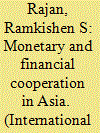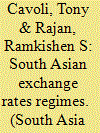|
|
|
Sort Order |
|
|
|
Items / Page
|
|
|
|
|
|
|
| Srl | Item |
| 1 |
ID:
078277


|
|
|
|
|
| Publication |
2007.
|
| Summary/Abstract |
This paper presents an empirical investigation on an important policy issue, namely, whether there is any evidence supporting monetary integration between the Chinese mainland and Hong Kong. We follow two lines of inquiry. First, we present a series of simple tests to find the extent to which trade and/or financial linkages exist between the two regions. Second, we use simple inflation and output differentials and structural VAR techniques to test for the degree of business cycle synchronization between the two regions. The results indicate that there is evidence supporting the existence of trade linkages and that there is also support for the possible synchronization of business cycles. We discuss the implications of this for monetary integration between Hong Kong and the mainland.
|
|
|
|
|
|
|
|
|
|
|
|
|
|
|
|
| 2 |
ID:
155206


|
|
|
|
|
| Summary/Abstract |
India undertook a monetary experiment of gigantic scale on November 8, 2016, that resulted in the withdrawal of the legal-tender character of Rs. 500 and Rs. 1000 currency. We make a preliminary attempt to analyze existing data to understand the various dimensions of the great monetary gamble.
|
|
|
|
|
|
|
|
|
|
|
|
|
|
|
|
| 3 |
ID:
076253


|
|
|
|
|
| Publication |
New Jersey, World Scientific, 2006.
|
| Description |
xxv, 481p.
|
| Standard Number |
9812564942
|
|
|
|
|
|
|
|
|
|
|
|
Copies: C:1/I:0,R:0,Q:0
Circulation
| Accession# | Call# | Current Location | Status | Policy | Location |
| 052320 | 303.482/KEL 052320 | Main | On Shelf | General | |
|
|
|
|
| 4 |
ID:
092619


|
|
|
|
|
| Publication |
2009.
|
| Summary/Abstract |
Ever since the currency crisis of 1997-98, there has been a great deal of interest in enhancing regional economic cooperation in Asia. It is important to keep in mind that economic regionalism is of multidimensional nature. The focus of this paper is on policy initiatives underway in Asia to enhance monetary and financial regionalism and the analytical bases for these initiatives, rather than on examining the de facto level of financial and monetary links that already exists (which may or may not have been facilitated via regional policy mechanisms). There are many gradations of monetary and financial regionalism, ranging from the weak form involving regional policy dialog and surveillance, on the one hand, to exchange rate and monetary coordination, on the other. To maintain focus, this paper concentrates more narrowly on 'medium forms' of monetary and financial regionalism, broadly defined as the development of regional liquidity arrangements and regional financial markets.
|
|
|
|
|
|
|
|
|
|
|
|
|
|
|
|
| 5 |
ID:
121189


|
|
|
|
|
| Publication |
2013.
|
| Summary/Abstract |
This article presents an analysis of the degree of de facto exchange rate flexibility in the exchange rate regimes for selected South Asian economies, viz., Bangladesh, India, Pakistan and Sri Lanka. Three commonly employed measures of exchange rate classification are used: a simple exchange market pressure (EMP) measure, a GARCH specification and a regression-based model. The article finds strong evidence of limited flexibility in all the South Asian economies-particularly against the US dollar, which can suggest a heavy degree of currency management. While Bangladesh, Pakistan and Sri Lanka effectively have fixed exchange rate regimes vis-à-vis the US dollar, India appears to operate somewhat more as a managed floater with a movement towards greater flexibility in recent years.
|
|
|
|
|
|
|
|
|
|
|
|
|
|
|
|
| 6 |
ID:
065898


|
|
|
|
|
|
|
|